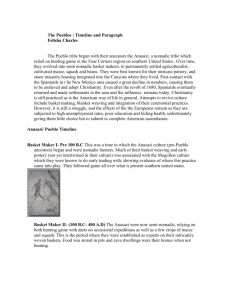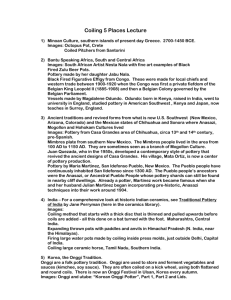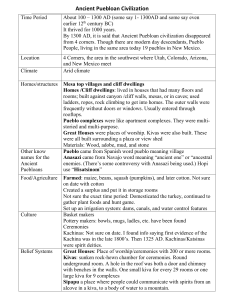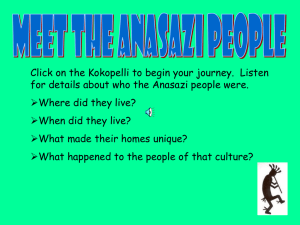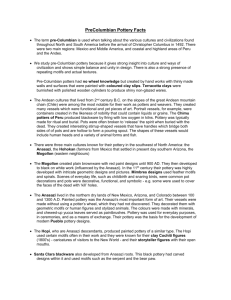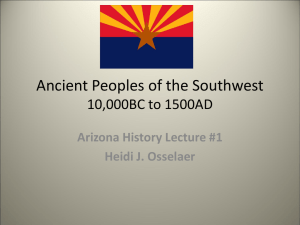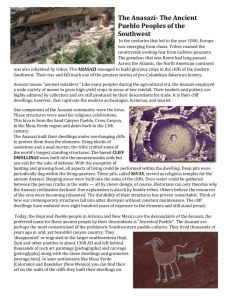Cats in the House - Humanities – Picturing America
advertisement
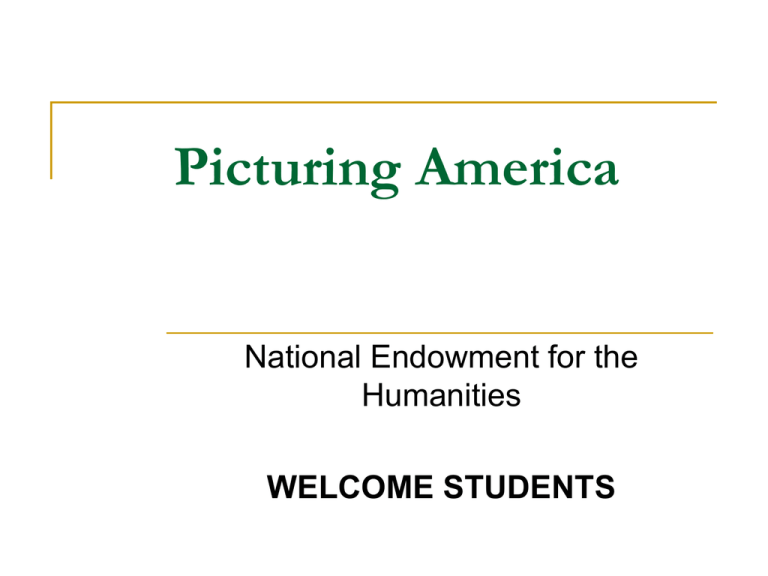
Picturing America National Endowment for the Humanities WELCOME STUDENTS What is this class all about ? This is a class about art that reflects North America that is presently the United States of America. This class will offer a way to understand the history of America. We will study art from 1100 AD to the present Art is not something that you just hang on the wall that looks good with the couch. WHY STUDY ART ? Art is a reflection of the time Art tells a story of people and a way of life Art evokes emotion When we gain an understanding of the past, we will be able to understand where we are as a nation and where we have come from and the foundations that made this country. ARE WE JUST LOOKING AT PICTURES? We will also be reading literature Watching movies Studying maps As well as writing….. Hopefully as a class we will discover other areas that we can gain more of an understanding of the time period. WHO ARE AMERICANS ? Have a greater sense of who Americans are Where Americans came from How Americans lived and now live How Americans adapted How Americans have grown as a nation STUDYING ART WILL Enable you to look at and appreciate works of art whether it is American or not. Recognize symbolism in art. Apply the time period of history to the artwork. Make connections with American history facts, geography and literature. CLASSROOM RULES Everyone is expected to participate. Please leave all cell phones in the basket. If you disrupt the class you will be asked to stop. If it persists, you will be asked to leave. You must bring your notebook, pen and any other material assigned for that day to class. Duh! Enjoy this class. IF YOU NEED TO CONTACT ME I will be communicating by email. My email is lorrainekpsmith@gmail.com Website: www.humanitiesusa.wordpress.com Please email me with questions, comments, absences. My home phone number is 952-0722. WHAT YOU NEED FOR CLASS A Three ring binder with tabs and paper. A pen. The assigned reading books: Common Sense, Across 5 Aprils, Up From Slavery. Native American Art ANASAZI – PUEBLO PEOPLE Lived c. 1100 – c.1960 Anasazi’s were farmers who built homesteads, small villages and a great cultural capital in Chaco Canyon, NM They engineered towns, multistory apartment buildings and a road network. By the Thirteenth century, they had abandoned the area and moved South to smaller settlements. Descendents- Pueblos ANASAZI LANDS THE FOUR CORNERS THE FOUR CORNERS ANASAZI INDIANS Anasazi History Pueblo Bonito is located in the Four Corners region in Chaco Canyon, New Mexico. It was constructed over a thousand year span by the Anasazi Indians. The formation of Pueblo Bonito is in the shape of a “D.” The Anasazi Indians are known for building what archeologist call “great houses.” Some of the architectural characteristics of the great houses include planned layouts, distinctive masonry, multi-story construction, and kivas (circular subterranean chambers). Pueblo Bonito also has many large rooms with no windows that have shelves that extend five feet out from the walls. These rooms are storage rooms or sleeping quarters. The oldest part of Pueblo Bonito dates back to about 850 AD. This earliest section consisted of 100 rooms ranging from one story rooms up to three story rooms. There were also 5 kivas surrounded by the multi-story rooms in a crescent shape. The location of Pueblo Bonito was unusual because they built it under a separated piece of a cliff wall. This piece was called “Threatening Rock,” standing 97 feet high and weighing about 30,000 tons. The Anasazi people recognized the threat and built a supporting terrace which slowed the erosion of the soil. The terrace worked well, because Threatening Rock did not fall until 1941. The culture and traditions known as Anasazi were formed around 700 AD after centuries of trading with the Hohokam people. Their typical houses were built out of stone terraces or adobe blocks around a central plaza with walls facing the outside for protection. The Anasazi people grew domesticated plants including maize, beans and squash. They were a sedentary people, living in one area and eating domesticated foods. Many Anasazi people would live in small farm houses in the summer. During the Basket Maker Period, the Anasazi people built granaries which became areas where towns were formed. During the drought of 1275 many farms and towns were abandoned, except for those around the Rio Grande River. The ones around the Rio Grande managed to survive through extensive irrigation systems. The Spanish visited the Pueblos in 1540; the Pueblos are descendants of the Anasazi people. From that point until present day, the Pueblo people have been ruled by the Spanish, Mexicans, and Americans. Today 22 Pueblo communities are still intact and running. The ruins of Chaco Canyon were first discovered in 1849 by Lt. James Simpson during a military expedition. Simpson's guide named Carravahal from San Juan Pueblo provided the name Pueblo Bonito, which is Spanish for “beautiful town.” At the conclusion of his expedition, Simpson published the first description of Chaco Canyon. Richard Wetherill, a rancher and archeologist, and George Pepper from the Museum of National History, were the first to excavate at Pueblo Bonito. They started their excavations in 1896 and ended in 1899. When they finished, Wetherill remained at Chaco Canyon running a trading post until he died in 1910. In the short period Wetherill and Pepper excavated, they uncovered 190 rooms, photographing and mapping all of the major structures in Chaco Canyon. Wetherill and Pepper contributed immensely to the early excavation of Chaco Canyon. UTAH UTAH UTAH ANASAZI POTTERY We do not know how these jars were used They are cylinder shaped, with small loops Geometric designs painted with black lines on white background, white slip, watery clay Drawn by hand with a relaxed asymmetry All have flat bottoms, some more stable Sikyatki c. 1350 - 1700 These people lived about 125 miles west of the First Mesa and developed a decorative style that was striking different from the symmetry and basic geometric designs of the jars found at Pueblo Bonito. Made of bare clay and decorated with a wider range of plant and mineral based colors. Fired at higher temperatures because of coal is now introduced pottery is more durable. SIKYATKI Decorations combine abstract geometric shapes with forms derived from nature: rain clouds, stars, the sun, animals, insects, reptiles, and birds. The human form is rarely depicted. See chart. -- This bowl has geometric decorations on the exterior, but greater attention is focused on the interior, which seems to contain a reptile SIKYATKI BOWL c. 1350 -1700 This bowl has geometric decorations on the exterior, but greater attention is focused on the interior, which seems to contain a reptile that slithers and spins around the inside. But a closer look reveals a creature that is something more than a reptile that commonly scurries over rocks in this arid land: it wears a three feather headdress, and its snout and one of its toes stretch to fantastic length. HOPI PEOPLE The Hopi people lived in the First Mesa area now. Their traditions recount the destruction of the Sikyatki community by its neighbors even before Spanish explorers arrived about 1583. The meaning of the symbolism of Sikyatki pottery has been forgotten, but it has been given new life at the end of the 19th century by a young Hopi-Tewa potter named Nampeyo (1860-1942) as she drew inspiration from Sikyatki pottery designs. They found commercial success, from the arrival of the railroad in Albuquerque in the 1880’s and the popularity of Arts and Crafts movement among collectors. Nampeyo’s work helped spark a revival in Hopi pottery that continues today. NAMPEYO c 1860 - 1942 NAMPEYO Hopi – Tewa Nation The village of Hano on Arizona's First Mesa was established around 1700 by Tewa refugees fleeing from Spanish oppression in New Mexico. Even though they learned many of the Hopi ways and intermarried into that Nation, the Tewa maintained their own speech and ceremonial practices. They became known as the Hopi-Tewa. In 1859 or 1860, Nampeyo was born to a Tewa mother and a Hopi father, and thus began a life that would gain fame and honor as a master potter of her people. Nampeyo became fascinated as a young child by the pottery made by her grandmother to serve the family's needs. As she grew, she began to make her own, and to experiment with different looks and styles. At the age of 20, she married only to be left by her husband because he feared that her beauty would make her seek other men! Shortly after this disappointment, Nampeyo began to wander in search of the remains of old pottery created by earlier generations. An archaelogical site had been established not far from her home, and she heard of pottery which was being uncovered in the excavations. Nampeyo and her new husband, Lesou, scoured the area finding all shapes and sizes of ancient pottery shards dating back to the Anasazi. Intrigued by the textures, color and design of these works, she began searching for different clays and unusual ways of mixing and baking the clay. She found ways of giving new life to the ancient designs she found, and had soon created a totally new look in Hopi pottery. When other potters discovered that her designs brought a higher price, Nampeyo's art was soon copied far and wide in the territory. Nampeyo has been credited by many authorities as being the artist who brought the beauty of this new Hopi pottery to the attention of the world. She became the symbol of Hopi culture, and was at the height of her fame from about 1901 to 1910. Her works have been collected by the National Museum in Washington, D.C. She left her homeland 3 times to appear with her creations: in 1905 and 1907 she went to the Hopi House at the Grand Canyon, and in 1910 to the U.S. Land and Irrigation Exposition in Chicago. Always her great supporter and helper, Lesou passed away in 1932. As she grew older, Nampeyo's eyes had begun to fail and Lesou had been invaluable in helping her to maintain the integrity of the art painted on her pottery. With his passing, her daughter Fannie took up her father's work and served as "eyes" for her mother until Nampeyo passed away in 1942. The three other surviving daughters born to Lesou and Nampeyo all were active in some manner with ceramic art. One of Nampeyo's grandaughters, Daisy Hooee is credited with introducing the art of relief settings into the exquisite creations of the Zuni silversmiths. Even though she enjoyed sculpting in silver, Daisy returned to the creation of pottery, and has always signed her art "Nampeyo" in honor of her esteemed grandmother. Maria Montoya Martinez (1887-1980) Jilian Martinez (1879-1943) Just as Nampeyo was reviving he Sikyatki Style in her community west of Chaco Canyon, another Pueblo potter was reviving an ancient style in her Tewa community, one hundred miles east of Chaco. Maria Montoya Martinez worked with her husband Julian Martinex to create a new style based on archaeological finds from the areas around San Idelfonso, 15 miles north of Santa Fe, New Mexico. English Pronunciation: "San Ill-day-fon-so" Traditional Name: Po-woh-ge-oweenge "Where the water cuts through" Martinez’s Style Made pots using the same coil-clay techniques that native potters had used a thousand years earlier. Julian then painted and fired them. In 1909, the couple were contacted by an archaeologist who asked them to find a way to reproduce the style of some of the ancient pottery that was black. It took them 8 years of experimentation and they finally discovered how to produce the arresting black on black finish. c. 1939 The geometric style with contrasting matte and gloss finishes characterizes their best known work. It’s Shape …. The jar is a study in opposing forces and restraint. The calculated design and natural irregularities combine to give the form and continual undercurrent of enger. Its bottom is slightly rounded and, when set on soft ground, snuggles into the earth. Positioned on a hard surface, however, the form balances on an invisible axis and appears to hover. It’s Shape …. Its silhouette is a combination of symmetrical and asymmetrical: The area of greatest volume (the pot’s belly) is situated exactly at mid-center. The jar is wider at the top than the bottom, and the pot’s outline curves inward in the top half. Color Contrasts … Even the black-on-black decoration holds hidden complications, containing a third color- white- wherever the surface reflects bright light. When the light is more subdued, the contrasts are less bold and the effect is more mysterious, as shapes move in and out of the shadows and negative and positive forms trade places. As though to keep all of these potent interactions in check, the abstract designs, refined and sharp as if it was cut paper, form a girdle around the pot’s circumference, stretching to a point just below the belly. Maria and Julian Martinez gained national recognition and led to a revival of potterymaking. Their pottery restored their economic base. Today, they command the respect of worldwide collectors of fine art. Other artists, potters and watercolor painters came to the attention of the public and although the Pueblo is one of the smallest in population, it is among the best known. Louisa Keyser (1850-1905) The Washoe People (about 700 miles NW of Four Corners) and their ancestors lived as nomads around the area of Lake Tahoe for several thousand years. Their way of life altered suddenly with the 1848 California Gold Rush and the discovery of silver in the Comstock Load in 1859. Travelers to California were followed by settlers who populated the Washoe area around Virginia City, Nevada. Washoe Peoples lives change … The settlers cut the trees, built roads, put up fences, and laid out ranches. Adjusting to the new cash economy, the Washoe abandoned their nomadic life and began to work for wages. Lake Tahoe Lake Tahoe in Winter Louisa Keyser For all of its upheaval, the cash-based economy brought a new market for the Washoe’s sophisticated basketry. Their weaving tradition had produced baskets fit for hunters-gathers, to be used as fish nets and cradles for infants. In 1895, Abe Cohn hired a young Southern Washoe woman to produce baskets exclusively for sale to non-native buyers. Lousia Keyser Dat So La Lee, whose birth name was "Dabuda", meaning "Young Willow" During her 30-year business arrangement with Cohn, Keyser produced scores of decorative baskets. Most notable, Washoe Degikup (Ceremonial baskets). She introduced new designs and experimented with shape and size to attract buyers. Dat So La Lee primarily used willow in the construction of her basketry. She would usually start out with 3 rods of willow and then weave strands around that. Her predominate style was a flat base, expanding out into its maximum circumference and tapering back to a hole in the top around the same size as the base. This is the degikup style that she popularized with Washoe basket weavers. The basket shown, a two-color degikup that Keyser make in 1904 or 1905, was constructed by coiling long strips of willow in layers and then connecting the rows with thousands of tiny stitches of thinner pieces of willow. Designs in redbud (red-brown color) and bracken fern (brown or black) were worked into the wave in a staggered pattern. The basket is shaped like a slightly squashed sphere, and opposing visual forces create a crisp tension. The coil rows make the form seem to swell outward, but the dark pattern checks the expansion by emphasizing the vertical with wiggling lines that appear to inch their way to the opening at the top. Commercial success encouraged other Washoe basket makers to follow Keyser’s lead. Although demand for Washoe baskets declined after 1935, Keyser helped transform the non-native perception of Washoe decorative basketry from utilitarian objects to works of art. Washoe Baskets made by Dat So La Lee Who has heard of the Antique’s Roadshow? How much are these Baskets worth? The largest is appraised at $25,000 to $75,000. The higher figure if the artist is known. A signed piece. So you might want to look around your house. You never know what you might find ! Coastal South Carolina An important tradition of basket weaving arrived from West Africa more than two hundred years ago, traveling by ship across the Atlantic with slaves. The decedents of those slaves still live in the long, narrow strip of Islands that stretches along the South Carolina and Georgia coasts. Coastal South Carolina Gullah is the name of their culture and their Creole language. During the 18th and 19th centuries (1700 &1800) in the Sea Islands, (those coastal barrier islands) rice plantation owners paid a premium for slaves from the rice-winnowing area of West Africa, who knew how to manage the crop. Gullah Culture Endures The marshy conditions that made the land ideal for rice also led to the isolation that created and then preserved the Gullah culture. After the Civil War, many Gullah purchased the land they once worked for others. They maintained their sense of separateness from the mainland and continued to make fine baskets. Caesar Johnson (1872 – 1960) The flat basket illustrated is a rice-winnowing tray attributed to Gullah artisan Caesar Johnson. These trays were used to separate out the chaff (the fry, outer husk) from the grain of rice after it was crushed in a mortar and pestle. Chaff is lighter than grain and when tossed together in a tray, the chaff floats away on the wind. Winnowing Tray and Other baskets Were made from bulrush (a type of marsh grass) and saw palmetto of white oak all of which grew in the area. The structure of the basket provides its only decoration. Its design evokes the motion of the tray in use: the spiraling coils seem to contract and expand- the center advancing, then retreating –while color variations and little diagonal stitches make the disk appear to rotate. Carl Toolak (1885 – 1945) Now we are travelling to Alaska to look at Baleen Baskets. Traditionally, baskets were made from Birchbark and made by women. A new and unusual basket form was developed in the early 20th century by male artisans. Alaska Carl Toolak Baleen Basket c. 1940 A non-native whaler, Charles Brower, commissioned a basket from a local man. It was unusual request because the basket was to be woven of baleen, the stiff, fibrous plates in the mouth of the baleen whale that filter plankton. Baleen Whales The Inupiat have hunted whales for centuries. Whales supplied food, fuel, and construction materials, and the Inupiat wasted none of it, including the baleen, a material that men traditionally worked. Baleen is pliable and resilient, making it ideal for sled runners, bows, rope, even shredded for fishing line. Baleen During the era of commercial whale hunting (1858 to around 1914), Westerners used baleen for buggy whips, umbrella ribs, and stays for women’s corsets. When petroleum and plastics replaced these whale products, commercial hunting dried up, and with it, jobs for Inupiat workers. Baleen Baskets Brower continued to commission baleen basket weavers to give as presents to his friends. Gradually, the demand broadened and a new tradition was born. Carl Toolak was among the first of the baleen basket weavers. This basket shows his style from around 1940. Baleen Baskets Because Baleen is too stiff to form tiny coils that begin the basket at the center bottom, Toolak used a starter plate of ivory He stitched the first strip of baleen to the edge of the starter plate through holes drilled around its perimeter, and finished the separate starter piece for the lid with a knob. Baleen Baskets Baleen occurs naturally in a range of shades from light brown to black. Toolak expanded his color range by adding a decoration of a white bird quills to the weave. The body of the container is glossy and is enriched with a pattern of white stitches grouped in twos and threes. The pattern lines up with that of the domeshaped lid, where trios of white stitches elongate into lines that converge toward the playful centerpiece of the work – a carved ivory seal who looks as though he has just popped his head above the icy water. Get out a piece of Notebook paper It is time to see what you have learned today. Think about it …… All the objects that we have studied today, how are these objects all similar? Think and Write about it ….. What natural materials from their environment did the artists and craftsmen use to create these functional containers? Why did the Washoe create and use mainly baskets rather than ceramic vessels? Think and write about it …… The Maria Martinez jar, the Anasazi jars, and the Sikyatki bowl were all made in the American Southwest by the Anasazi or their Pueblo Descendants. What features do they have in common? Think and Write about it …… How did American tourism in the Southwest influence American Indian pottery? Think and Write about it …… In the early 20th century, what did tourists appreciate about SW pottery? Think and Write About it …. Why did collectors prefer pottery that was signed by the artist?
